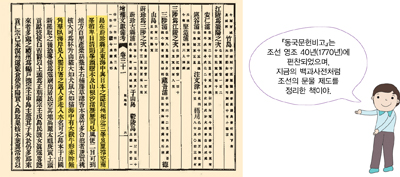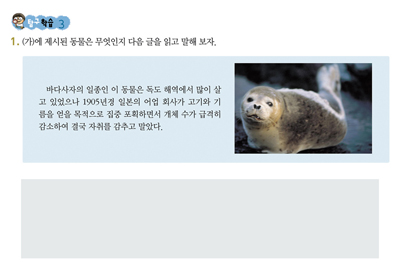- Dokdo in the East Sea
- Educational material
- Junior High School Version
Dokdo in the East Sea
Table of Contents Open Contents
- Dokdo: Korean Territory
- Dokdo: Keeper of the East Sea!
- Ulleungdo and Dokdo: We’re Siblings!
- Dokdo’s Been Korean Land Since the Three Kingdoms Period!
- Dokdo’s Been Korean Land in the Modern Era!
- Dokdo Appears Even on Old Maps!
- Mission: Protect Dokdo!
- Others Have Known, Too ... That Dokdo Is Korean Land!
- Dokdo Is Korean Land Even on Old Japanese Maps!
- Japan’s Claims to Dokdo Are False!
Discovery Learning 3
Ulleungdo and Dokdo in the late Joseon period[Teacher Notes]
-
- Compilation of Reference Documents on the Eastern Country (1770)
-
According to the Joseon Gazetteer, “Ulleung and Usan are both a part of Usan, and Usan is what foreigners refer to as ‘Songdo.’”
- 輿地志云 鬱陵于山皆 于山國地于山則倭所謂松島也

Comprehensive Study of Civilization, Revised and Expanded (1908)
Comprehensive Study of Civilization, Revised and Expanded was completed in 1908, and resembles a modern encyclopedia in the information provided.

(A) A large animal lives in the middle of the sea. They have an appearance similar to that of a cow with red eyes but lack horns. They live on the coast in droves and scatter into the water upon seeing humans. (Omitted)
-
- Discovery Learning 3
-
1. Read the following paragraph and guess the animal being described in (A).[Answer]
-
This animal species is part of the sea lion family and existed in large numbers near Dokdo. Around 1905, Japanese fishing companies hunted them for meat and oil, and their numbers declined sharply, resulting in their extinction.
Teacher Notes
Compiled in the late Joseon period, the Reference Compilation of Reference Documents on the Eastern Country contains even more detailed records about Ulleungdo and Dokdo. As in the “Geographical Records,” this text indicates that Ulleungdo and Dokdo are close enough that the other can be seen on a clear day. They also contain detailed descriptions of the peaks on Ulleungdo and Dokdo. The documents include information about the animal life in and around Dokdo. However, unlike as in the “Geographical Records,” Dokdo is sometimes referred to as Sambongdo. Furthermore, the records state that Dokdo was referred to as “Songdo” in Japan, thus indicating Joseon’s sovereignty over the islet.
닫기
Answer
1.“Gangchi” (Zalophus japonicas), also known as the Dokdo Sea Lion or the Japanese Sea Lion (pictured). Although they are known to have existed in large numbers around Dokdo, extensive hunting led to their extinction.
닫기











